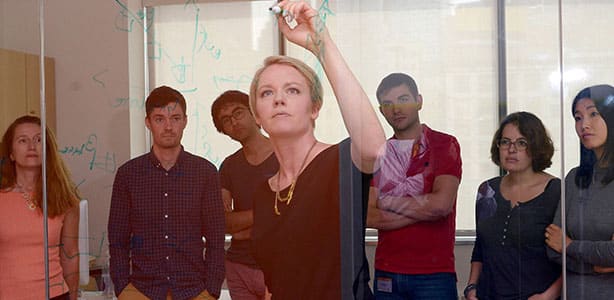New York Genome Center and Columbia University Researchers Seek to Discover Why Identical Genetic Mutations Cause Disease in Some People but Not in Others
Tuuli Lappalainen, PhD, Core Faculty Member at the New York Genome Center, and Assistant Professor in the Department of Systems Biology at Columbia University, has been awarded a 5-year, $1.7 million R01 grant from the National Institute of General Medical Sciences of the National Institutes of Health. This grant will support Dr. Lappalainen’s research on why individuals carrying identical gene mutations for a disease end up having varying severity or symptoms of the disease. The Lappalainen Lab will focus its research efforts on advancing scientific knowledge of a widely acknowledged but not well understood phenomenon called variable penetrance, where the severity of the effect of disease-causing variants differs among individuals who carry them.
Dr. Lappalainen, the study’s principal investigator, will explore a specific type of modified penetrance, where a genetic variant that affects the regulation of a given gene also affects how severe an affect another variant inside that gene will have. The Lappalainen Lab will examine the important implications of variable penetrance in human evolution and disease. A clearer understanding of penetrance of disease-causing gene variants could enable clinicians to better predict an individual’s risk of having a given disease, as well as its severity.
Dr. Lappalainen and her research team will focus on how haplotype epistasis–a phenomenon in which gene variants in close proximity to one another on the same chromosome interact–affects penetrance. Comprehensive, integrated analysis of haplotype epistasis has been lacking in the scientific literature, and Dr. Lappalainen’s study will provide much needed insight into the resulting epistatic selection in human populations and the role it plays in genetic risk for disease. To determine which gene variants lie in the same chromosome and may act together, the researchers will use phASER, a novel method and software tool recently developed by the Lappalainen Lab.
“Our goal is to explore new ways to look at how genetic variants function together with each other, and what kind of effect that interaction has on human traits and disease,” says Dr. Lappalainen. “What we are focusing on in our research is to describe the basic paradigms and concepts of what is happening on a cellular level. We propose to demonstrate that these interactions actually do exist in the human genome and to determine their significance.”
In the study, the scientists plan to leverage their expertise in population genetics of regulatory, coding and disease-associated genetic variation. They will utilize genetic information from many of the largest human genetic datasets, and of diseases with diverse genetic architectures. The genomic databases include sequencing data of various diseases, including a dataset comprised of 2,500 families affected by autism. Autism was chosen, Dr. Lappalainen says, in order to study a disease that is primarily caused by very rare, severe mutations. The project will be driven by the Lappalainen Lab, and will also include a collaboration with Dr. Daniel MacArthur’s lab at Massachusetts General Hospital and the Broad Institute of Harvard and MIT.
A unique aspect of the project, according to Dr. Lappalainen, is the integration of different domains of human genetics that have previously been studied in isolation. For example, she says, variants that affect the coding region of a gene and typically change an amino acid or completely destroy the protein structure have often been studied in the context of rare, severe diseases, while the analysis of genetic variants that affect gene regulation, such as gene expression levels, are often analyzed in the context of common complex diseases. Few researchers, Dr. Lappalainen says, have analyzed the joint effects of both of these variants.
“In this project, we will study many different kinds of diseases, including cancer, rare diseases and common diseases, to analyze how haplotype epistasis affects all kinds of disorders, rather than just focusing on one specific type of disease,” Dr. Lappalainen says. “This will be the first comprehensive work on characterizing how important this phenomenon is and how it can affect penetrance of disease-causing variants.”
As part of the project, researchers will experimentally recreate different combinations of variants identified from the sequencing data and test their interaction, utilizing the CRISPR-Cas genome editing method to introduce gene mutations at specific locations in the DNA of human cells grown in the lab. This will allow scientists to test how severely the different combinations of regulatory and coding mutations affect the cells’ traits.
*Research reported in this press release will be supported by the National Institute of General Medical Sciences of the National Institutes of Health under Award Number R01GM122924. The content is solely the responsibility of the authors and does not necessarily represent the official views of the National Institutes of Health.
About the New York Genome Center
The New York Genome Center is an independent, nonprofit academic research organization at the forefront of transforming biomedical research and clinical care with the mission of saving lives. A collaboration of renowned academic, medical and industry leaders across the globe, the New York Genome Center has as its goal to translate genomic research into development of new treatments, therapies and therapeutics against human disease. Its member organizations and partners are united in this unprecedented collaboration of technology, science and medicine, designed to harness the power of innovation and discoveries to advance genomic services. Their shared objective is the acceleration of medical genomics and precision medicine to benefit patients around the world. For more information, visit our website at www.nygenome.org.
Member institutions include: Albert Einstein College of Medicine, American Museum of Natural History, Cold Spring Harbor Laboratory, Columbia University, Hospital for Special Surgery, The Jackson Laboratory, Memorial Sloan Kettering Cancer Center, Icahn School of Medicine at Mount Sinai, NewYork-Presbyterian Hospital, The New York Stem Cell Foundation, New York University, Northwell Health, Princeton University, The Rockefeller University, Roswell Park Cancer Institute, Stony Brook University, Weill Cornell Medicine and IBM.
